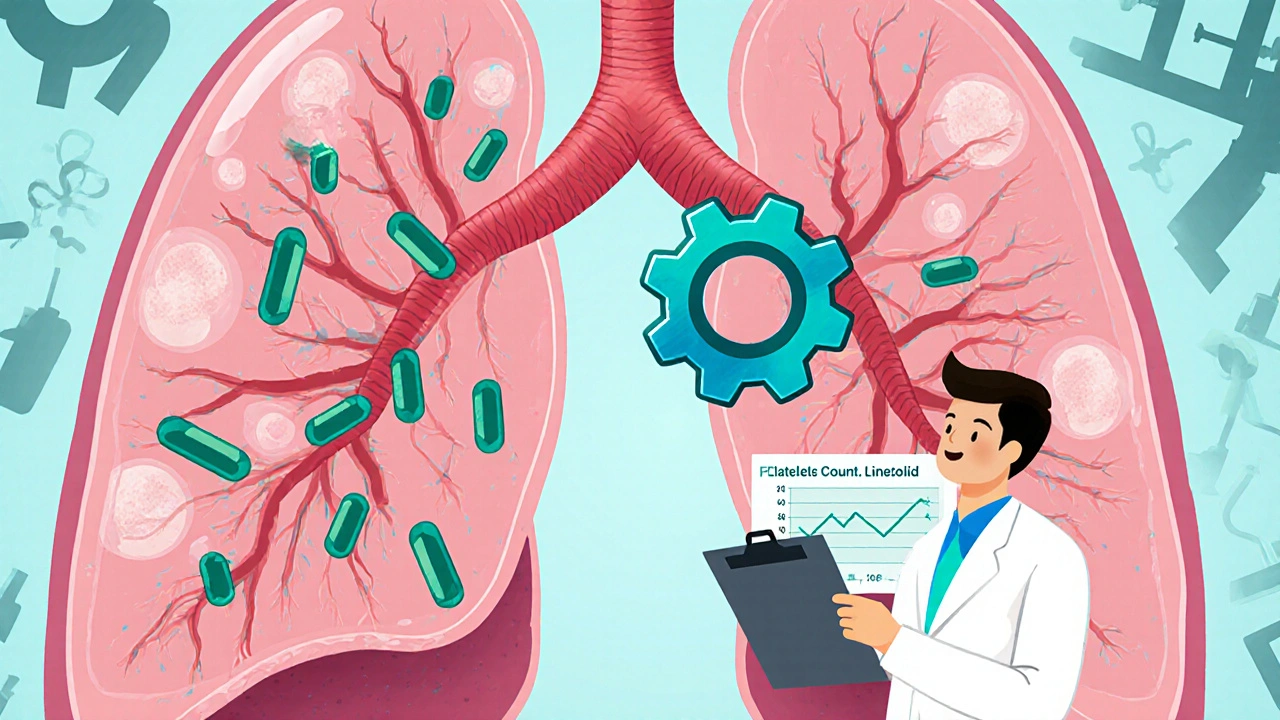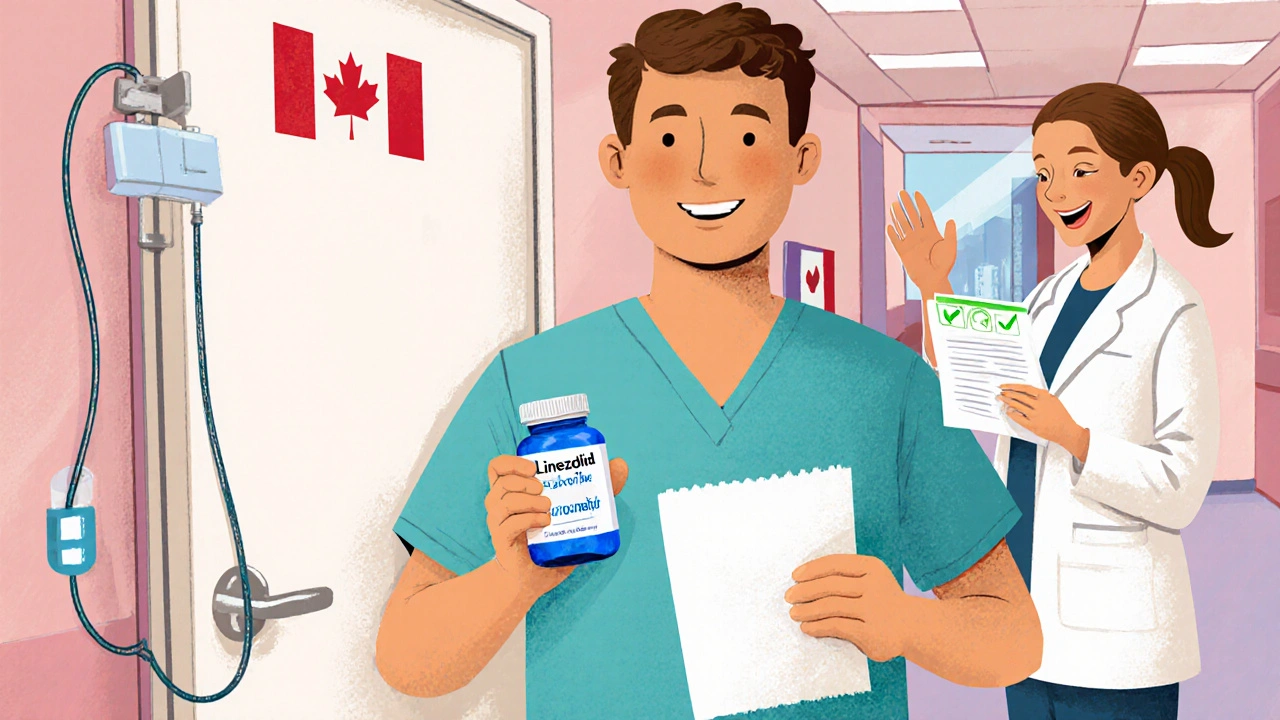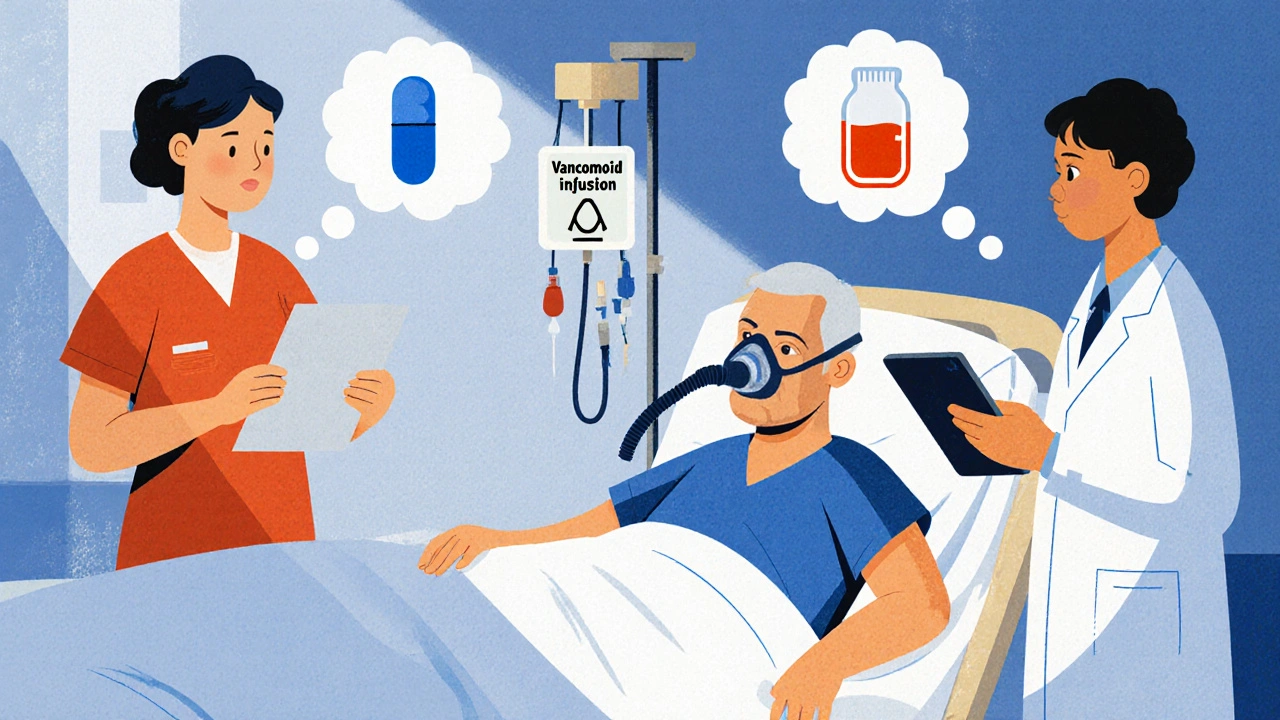Linezolid Therapy Monitoring Tracker
Patient Monitoring Overview
Track required monitoring for patients receiving linezolid therapy. Linezolid requires monitoring for thrombocytopenia, peripheral neuropathy, and serotonin syndrome, especially for therapy exceeding 10 days.
Patient Information
Therapy Details
Monitoring Schedule
Platelet Count
Weekly monitoring required
Neurological Symptoms
Daily assessment for tingling/numbness
Drug Interactions
Avoid serotonergic agents
Monitoring Results
| Date | Parameter | Value | Assessment | Status |
|---|---|---|---|---|
| Day 1 | Platelets | 150 × 10⁹/L | Normal | Within Normal Range |
| Day 7 | Platelets | 120 × 10⁹/L | Low | Monitor Closely |
| Day 10 | Platelets | 85 × 10⁹/L | Severe | Discontinue Therapy |
Key Takeaways
- Linezolid is an oxazolidinone antibiotic with strong activity against MRSA and other gram‑positive pathogens causing hospital‑acquired pneumonia.
- Clinical trials show higher clinical cure rates for linezolid compared with vancomycin, especially in lung tissue.
- Typical dosing is 600 mg IV or PO every 12 hours for 10‑14 days, but renal adjustment is not required.
- Monitoring for thrombocytopenia, peripheral neuropathy, and serotonin syndrome is essential during prolonged therapy.
- Linezolid is most useful when patients have vancomycin‑failure, renal impairment, or when oral step‑down therapy is needed.
When treating nosocomial pneumonia, clinicians often juggle efficacy, safety, and the practicalities of delivering IV therapy in a busy ward. One drug that consistently pops up in the discussion is linezolid. In this article we’ll unpack why linezolid has become a go‑to option, how it stacks up against the classic vancomycin regimen, and what everyday prescribing pitfalls to watch out for.
Understanding Nosocomial (Hospital‑Acquired) Pneumonia
Nosocomial pneumonia, also called hospital‑acquired pneumonia (HAP), is an infection that develops 48 hours or more after admission and wasn’t incubating at the time of entry. The most common culprits are gram‑positive organisms like Staphylococcus aureus (including MRSA) and Streptococcus pneumoniae, but gram‑negative rods and atypical pathogens also figure in mixed infections. Because patients are often on ventilators, have invasive lines, or are immunocompromised, the infection can progress quickly, making early, appropriate antimicrobial therapy a critical determinant of survival.
What Is Linezolid?
Linezolid belongs to the oxazolidinone class and works by binding to the 50S ribosomal subunit, blocking the formation of the initiation complex for bacterial protein synthesis. This mechanism is unique among antibiotics, giving linezolid activity against strains that have acquired resistance to other protein‑synthesis inhibitors. It is highly bioavailable (≈100 % oral absorption), penetrates lung tissue well, and reaches concentrations in epithelial lining fluid that exceed the MIC for most gram‑positive pathogens.
Clinical Evidence Supporting Linezolid in HAP
Several randomized controlled trials have compared linezolid to vancomycin for treating MRSA‑related HAP. The 2005 ZEPHYR trial enrolled 702 patients and reported a 64 % clinical cure rate for linezolid versus 53 % for vancomycin (p = 0.02). A 2012 meta‑analysis of five trials (total 1,154 participants) confirmed a pooled odds ratio of 1.45 favoring linezolid for cure, while mortality differences were not statistically significant. Real‑world cohort studies from 2020‑2024 also show lower rates of treatment discontinuation due to nephrotoxicity with linezolid, an important factor in patients already battling renal insufficiency.

Linezolid vs. Vancomycin: A Direct Comparison
| Aspect | Linezolid | Vancomycin |
|---|---|---|
| Drug class | Oxazolidinone | Glycopeptide |
| Oral bioavailability | ~100 % (excellent) | Not applicable (IV only) |
| Lung tissue penetration | High (ELF > MIC) | Moderate |
| Typical dose | 600 mg every 12 h (IV or PO) | 15‑20 mg/kg every 12 h (IV) |
| Key adverse effects | Thrombocytopenia, neuropathy, serotonin syndrome | Nephrotoxicity, ototoxicity, Red Man syndrome |
| Clinical cure rates (meta‑analysis) | ~64 % | ~53 % |
| Renal dosing adjustments | None required | Yes, based on CrCl |
Practical Dosing and Monitoring
Linezolid is administered as 600 mg every 12 hours, either intravenously or orally. Because oral absorption matches IV, clinicians often start with IV for severe cases and switch to PO once the patient can tolerate oral intake, simplifying discharge planning. No dose reduction is needed for renal impairment, but hepatic dysfunction (Child‑Pugh C) may warrant caution.
Adverse effects demand regular labs. Platelet counts should be checked at baseline, then weekly; a drop below 100 × 10⁹/L signals the need to reassess therapy. Peripheral neuropathy can be insidious-patients should report tingling or numbness promptly. Because linezolid is a reversible MAO inhibitor, avoid concurrent serotonergic agents (SSRIs, SNRIs, tramadol) to prevent serotonin syndrome.
Choosing the Right Patients
Linezolid shines in three scenarios:
- Documented or highly suspected MRSA pneumonia when vancomycin failures or high MICs (>1 µg/mL) are observed.
- Patients with acute kidney injury or chronic renal failure where vancomycin dosing becomes cumbersome.
- When an oral step‑down is needed early, such as after 48‑72 hours of IV therapy, allowing discharge without a PICC line.
Conversely, avoid linezolid in patients with a history of severe thrombocytopenia, uncontrolled hypertension (due to possible interaction with MAO inhibition), or those already on multiple serotonergic drugs unless the benefits outweigh the risks.

Common Pitfalls and How to Avoid Them
Even with solid data, mistakes happen:
- Under‑monitoring platelets: A platelet check only at the start can miss a later decline. Set a weekly lab schedule.
- Ignoring drug‑drug interactions: Many ICU patients receive SSRIs for delirium; a quick medication reconciliation prevents serotonin syndrome.
- Extending therapy beyond 14 days: Prolonged exposure raises the risk of neuropathy. Re‑evaluate need after 10 days.
- Assuming oral is always safe: In patients with severe vomiting or malabsorption, stick with IV until stability returns.
Future Directions
Research is now probing linezolid’s role in combination regimens, such as adding a beta‑lactam to broaden coverage against gram‑negative co‑pathogens. Ongoing trials (2025‑2026) also look at shorter courses (7 days) in patients who achieve early microbiological clearance, which could reduce toxicity while preserving efficacy.
Quick Reference Checklist
- Indication: MRSA‑related HAP, especially when vancomycin fails or renal function limits dosing.
- Dose: 600 mg q12h IV/PO for 10‑14 days.
- Monitor: CBC (platelets) weekly, neurological symptoms, and drug interactions.
- Switch to oral: feasible after 48‑72 h of clinical improvement.
- Stop if: platelets <100 × 10⁹/L, severe neuropathy, or serotonin syndrome signs.
Frequently Asked Questions
Is linezolid effective against gram‑negative bacteria?
Linezolid’s activity is limited to gram‑positive organisms. For mixed infections that include gram‑negative rods, clinicians usually add a β‑lactam or a fluoroquinolone to cover the broader spectrum.
Can linezolid be used in patients with liver disease?
Mild to moderate hepatic impairment does not require dose adjustment, but severe liver failure (Child‑Pugh C) can increase drug exposure, so clinicians should monitor liver enzymes and consider alternatives if toxicity emerges.
What is the main reason to prefer linezolid over vancomycin?
The key advantages are excellent oral bioavailability, better lung tissue penetration, and a lower risk of nephrotoxicity, making it attractive for patients needing early step‑down to oral therapy or those with renal dysfunction.
How often should platelet counts be checked?
Baseline, then weekly during treatment. If counts drop rapidly or the patient shows bleeding, increase monitoring to every 2‑3 days.
Is there a risk of resistance developing to linezolid?
Resistance is rare but has been reported via mutations in the 23S rRNA gene. Using appropriate dosing, limiting therapy to 14 days, and avoiding unnecessary prophylactic use helps keep resistance low.

Tionne Myles-Smith
October 20, 2025 AT 00:53Jordyn Holland
October 21, 2025 AT 19:29Jasper Arboladura
October 21, 2025 AT 21:11Joanne Beriña
October 23, 2025 AT 19:34ABHISHEK NAHARIA
October 25, 2025 AT 18:31Hardik Malhan
October 27, 2025 AT 17:01Casey Nicole
October 28, 2025 AT 22:19Tionne Myles-Smith
October 29, 2025 AT 21:02